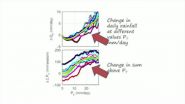(Press-News.org) This news release is available in German.
Platinum is a great catalyst and can be used for many different applications. It's expensive stuff though, so tiny platinum nanoparticles sitting on cheap metal oxide materials are used to convert harmful carbon monoxide into carbon dioxide. Using scanning tunnelling microscopes, scientists at TU Vienna have now been able to image the catalytic behaviour of platinum sitting on iron-oxide, which allowed them to explain the process on an atomic scale. Surprisingly, the chemical reactions do not take place on the platinum nanoparticles themselves, and it is the interplay between platinum particles and the iron-oxide surface that makes the reaction so efficient.
Catching and Oxidising Molecules
The tiny nanoparticles used for catalysis often consist of only a few platinum atoms. They enable oxidation by keeping target molecules in place and bringing them into contact with oxygen. That way, carbon monoxide (CO) can be turned into carbon dioxide (CO2), hydrogen gas (H2) is oxidized to water (H2O). These reactions are also possible without platinum, but they can occur at much lower temperatures in the presence of platinum particles.
"We used to believe that these chemical reactions occur right on top of the platinum particles. But our pictures clearly show that the iron oxide really does the job", says Professor Gareth Parkinson. For years he has been studying the behaviour of tiny particles on metal-oxide surfaces together with Professor Ulrike Diebold (both TU Vienna). Now the team could show that the oxygen needed for the chemical reactions does not originate from the surrounding atmosphere but from the iron oxide below.
Nano-Holes and Travelling Iron
The iron oxide (Fe3O4), on which the platinum particles rest, has remarkable properties. It has a regular crystal structure and each atom has its well-defined position, but still the iron atoms are relatively free to travel through the material. When the platinum nanoparticles catch molecules from the surrounding gas and combine them with oxygen atoms from the iron-oxide surface, a surplus of iron atoms remains. These iron atoms then migrate deep into the material, leaving a hole in the surface that can clearly be seen in the pictures taken with the scanning tunnelling microscope.
This process can even trigger a chain reaction. As soon as the chemical reaction at the platinum nanoparticle creates a hole in the iron-oxide surface, there are some atoms right at the edge of the hole whose coupling to the rest of the material is not very strong. At these edges the next chemical reaction can occur much more easily. The platinum nanoparticle is shifted slightly and it is ready for the next step. "In the end, we can see long trenches on the surface, left behind by a single platinum nanoparticle", says Ulrike Diebold.
The opposite phenomenon occurs when platinum and iron-oxide is exposed to an oxygen atmosphere. The platinum particles break up the oxygen molecules (O2), and the single oxygen atoms can then be integrated into the surface. Iron atoms travel to the surface from within the material, and right next to the platinum nanoparticle, an additional iron-oxide island is created. Instead of holes, many small islands grow on the surface.
Towards Better Catalysts
For years the team at TU Vienna has been working hard to lay the necessary groundwork for this kind of research. In many important steps the surface-science team perfected ways to handle metal oxides and tiny particles. In recent years, the have presented important new findings about the structure of metal oxides, about the mobility of atoms on their surface and their chemical properties. Based on this experience, it is now possible to make the chemical processes of platinum catalysis visible and to explain them in detail.
Now this new knowledge can be used to create even better catalysts. For instance, the team could show that pre-treating with hydrogen should increase the efficiency of platinum catalysts. The atomic trenches created that way keep the platinum nanoparticles from clustering, which would decrease their reactivity.
INFORMATION:
Researchers at the University of Birmingham have shown how the development of coated silica nanoparticles could be used in restorative treatment of sensitive teeth and preventing the onset of tooth decay.
The study, published in the Journal of Dentistry, shows how sub-micron silica particles can be prepared to deliver important compounds into damaged teeth through tubules in the dentine.
The tiny particles can be bound to compounds ranging from calcium tooth building materials to antimicrobials that prevent infection.
Professor Damien Walmsley, from the School of ...
This news release is available in German.
Topical research experiments are often too expensive or too complex to be rebuilt and incorporated in teaching. How can one, nevertheless, make modern science accessible to the public? This challenge was tackled in the research group Quantum Nanophysics led by Markus Arndt at the University of Vienna. For the first time, two research laboratories were created as complete, photorealistic computer simulations allowing university and high-school students as well as the general public to virtually access unique instruments. ...
EUGENE, Ore. -- (Sept. 16, 2015) -- New research at the University of Oregon finds that an organization's logo on a food product can trigger quick perceptions by consumers about an item's healthiness and influence their decision-making.
That perception also may be seen as an endorsement that may not exist, say study co-authors Elizabeth Minton of the University of Wyoming and T. Bettina Cornwell, the Edwin E. & June Woldt Cone Professor of Marketing in the Lundquist College of Business at the UO.
The research, led by Minton as part of her doctoral dissertation at the ...
TORONTO [11 September 2015] A team of astronomers has given us our best view yet of an exoplanet moving in its orbit around a distant star. A series of images captured between November 2013 to April 2015 shows the exoplanet β Pic b as it moves through 1 ½ years of its 22-year orbital period.
First discovered in 2008, β Pic b is a gas giant planet ten to twelve times the mass of Jupiter, with an orbit roughly the diameter of Saturn's. It is part of the dynamic and complex system of the star β Pictoris which lies over 60 light-years from Earth. The ...
The use of antidepressants during pregnancy has no long term neurodevelopmental or behavioural effects on the child, however they may be associated with an increased risk of postpartum haemorrhage, suggests the findings from three studies published in BJOG: An International Journal of Obstetrics and Gynaecology (BJOG).
Depression and anxiety are the most common mental health problems during pregnancy, with around 12% of women in the UK experiencing depression at some point during pregnancy and the postnatal period. The use of antidepressants such as selective serotonin ...
Stanford University School of Medicine researchers and their colleagues are calling for an urgent re-evaluation of global guidelines for the treatment of parasitic-worm diseases in light of a new study showing that large-scale treatment programs are highly cost-effective.
Parasitic-worm diseases afflict some 1.5 billion people in the developing world, causing gastrointestinal problems, anemia, wasting, and cognitive and growth deficits in children, and in some cases, liver, bladder and intestinal problems that can be fatal. About 150,000 people die of complications from ...
CANCER RESEARCH UK scientists have found how cells adapt to overcome cancer drugs designed to interfere with their genetic controls, according to a study* published today (Wednesday) in Epigenetics and Chromatin.
Normally molecular 'tags' are attached to DNA which send signals to the cell, telling it how to package its DNA and switch genes on or off.
Drugs called HDAC inhibitors cause a build-up of certain types of tags, leading to potentially damaging changes in gene activity that can kill cancer cells.
But while HDAC inhibitors can successfully treat certain types ...
An accidental find of a collection of young red dwarf stars close to our solar system could give us a rare glimpse of slow-motion planet formation.
Astronomers from The Australian National University (ANU) and UNSW Canberra found large discs of dust around two of the stars, tell-tale signs of planets in the process of forming.
"We think the Earth and all the other planets formed from discs like these so it is fascinating to see a potential new solar system evolving," said the lead researcher Dr Simon Murphy, from the ANU Research School of Astronomy and Astrophysics.
"However, ...
New research at the University of Warwick with colleagues from the London School of Economics has identified changes in the shape of rainfall across Europe; changes in the amount of drizzle compared with downpours and everything in-between.
Professor Sandra Chapman of the University of Warwick and co-authors Professor Nicholas Watkins and Dr David Stainforth from the London School of Economics have today published new research demonstrating how the variability in the way it rains makes it intrinsically difficult to identify the character of local climate change. Difficult ...
HANOVER, N.H. - Warming temperatures are causing Arctic mosquitoes to grow faster and emerge earlier, significantly boosting their population and threatening the caribou they feast on, a Dartmouth College study finds.
The study predicts the mosquitoes' probability of surviving and emerging as adults will increase by more than 50 percent if Arctic temperatures rise 2 °C. The findings are important because changes in the timing and intensity of their emergence affect their role as swarming pests of people and wildlife, as pollinators of tundra plants and as food for ...







